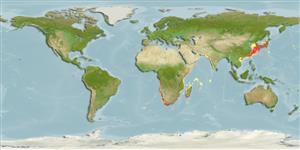Common names from other countries
Environment: milieu / climate zone / depth range / distribution range
Ecología
marino bentopelágico; rango de profundidad 20 - 400 m (Ref. 6637). Temperate
Indo-West Pacific: Mozambique and South Africa (Ref. 6637), Japan and the East China Sea. Southeast Atlantic: Cape, South Africa (Ref. 6637).
Tamaño / Peso / Age
Maturity: Lm ? range ? - ? cm
Max length : 150 cm TL macho / no sexado; (Ref. 559); peso máximo publicado: 16.1 kg (Ref. 40637)
Short description
Claves de identificación | Morfología | Morfometría
Espinas dorsales (total) : 9 - 10; Radios blandos dorsales (total) : 13 - 14; Espinas anales: 3; Radios blandos anales: 12 - 13. Adults black in color; juveniles dusky silver.
Adults found in deep rocky areas; young found in shallow water. The diet consists of fishes, crustaceans and squids. Spawns from October to March.
Life cycle and mating behavior
Maturities | Reproducción | Spawnings | Egg(s) | Fecundities | Larva
Heemstra, P.C., 1986. Scombropidae. p. 563. In M.M. Smith and P.C. Heemstra (eds.) Smiths' sea fishes. Springer-Verlag, Berlin. (Ref. 6637)
IUCN Red List Status (Ref. 130435)
CITES (Ref. 128078)
Not Evaluated
Threat to humans
Harmless
Human uses
Herramientas
Special reports
Download XML
Fuentes de Internet
Estimates based on models
Preferred temperature (Ref.
115969): 10.4 - 22.6, mean 18.2 (based on 218 cells).
Phylogenetic diversity index (Ref.
82804): PD
50 = 0.7500 [Uniqueness, from 0.5 = low to 2.0 = high].
Bayesian length-weight: a=0.01072 (0.00415 - 0.02764), b=3.02 (2.80 - 3.24), in cm Total Length, based on LWR estimates for this (Sub)family-body shape (Ref.
93245).
Nivel trófico (Ref.
69278): 4.2 ±0.63 se; based on food items.
Resiliencia (Ref.
120179): Bajo, población duplicada en un tiempo mínimo de 4.5-14 años (K=0.12).
Fishing Vulnerability (Ref.
59153): High to very high vulnerability (68 of 100).
